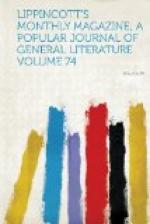The young man confessed that he had specimens of the best kinds of flat-flame burners in his pocket. He quickly brought from his overcoat in the hall a small paper parcel from which he produced several bright little brass tubes, explaining that he carried them because somebody was always inquiring about the best kind of burner. “These save talk,” said he.
With a small wrench he removed one of the old burners, and the several kinds were successively tested in its place. Some gave a better light, but it was objected that they might consume more gas. Whereupon the chemist tore a strip from his well-worn handkerchief, and, having damped it, wound the ribbon several times around the top of the old burner (which had been replaced), leaving the orifice uncovered. The new burner was screwed down over this, making a gas-tight connection. “There,” said he, “we have a gauge. The new burner will receive the same amount of gas that the old one consumed—no more, no less—but the current is slightly checked.”
The burner gave the same amount of light as before, so far as the eye could perceive.
“In the combustion of gas for heating purposes,” continued the chemist, “seek the burner with free, rapid delivery through small holes. For light you want something different. Suppose you send a current of gas up into this sewing-thimble: it can find an exit only by turning backward. Then suppose it escapes from the thimble only to enter a larger cavity above it, whence it must issue through a burner-tip with an orifice of the usual size. The current, you perceive, is twice completely broken. It will be seen that only the expansive force of the gas, together with its buoyancy, acts upon the jets, instead of a direct current. Now, it will always be found that the burner which best carries out the principles just illustrated—other points being equal—will give more light with a less quantity of gas than any other. This also exhibits the chief principle of most of the governors or regulators.
“You will observe that this checking of the current is attained in various ways in different burners,” continued the chemist as he unscrewed and dissected the samples before him. “In some it is done by a perforated metal disk in the orifice; in others, by a bit of wool, which checks slightly a slow current, and by the pressure of a strong one becomes compacted and forms a more effective obstacle. In most cases, however, it soon becomes solid with condensed matters from the gas. Another form of check is a small cap having perpendicular slits at the sides. The cylinder of the cap, being smaller than the orifice of the burner, screws down into it; the openings being shortened or lengthened according as the cylinder is screwed up or down. One objection to this is the trouble required in regulating. Here is another burner, in which the orifice ends in a cap whose sides, near the bottom, are pierced with four pin-holes directed downward. This reverses the




